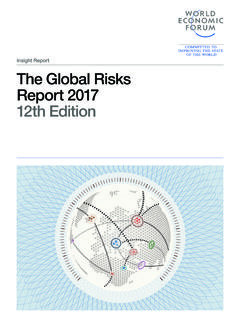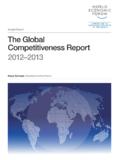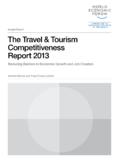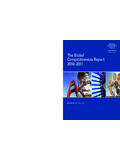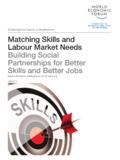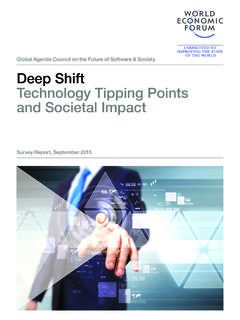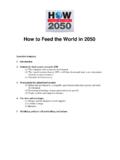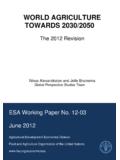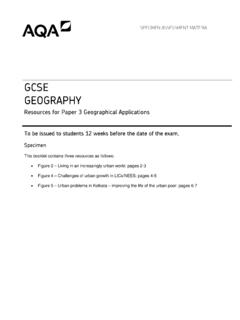Transcription of Insight Report The Global Risks Report 2016 11th …
1 The Global Risks Report 201611th EditionInsight ReportWorld Economic Forum91-93 route de la CapiteCH-1223 Cologny/GenevaSwitzerlandTel.: +41 (0) 22 869 1212 Fax: +41 (0) 22 786 Global Risks Report 2016, 11th Edition is published by the World Economic Forum within the framework of The Global Competitiveness and Risks information in this Report , or on which this Report is based, has been obtained from sources that the authors believe to be reliable and accurate. However, it has not been independently verified and no representation or warranty, express or implied, is made as to the accuracy or completeness of any information obtained from third parties. In addition, the statements in this Report may provide current expectations of future events based on certain assumptions and include any statement that does not directly relate to a historical fact or a current fact. These statements involve known and unknown Risks , uncertainties and other factors which are not exhaustive.
2 The companies contributing to this Report operate in a continually changing environment and new Risks emerge continually. Readers are cautioned not to place undue reliance on these statements. The companies contributing to this Report undertake no obligation to publicly revise or update any statements, whether as a result of new information, future events or otherwise and they shall in no event be liable for any loss or damage arising in connection with the use of the information in this Economic ForumGenevaWorld Economic Forum 2016 All rights reserved. All rights reserved. No part of this publication may be reproduced, stored in a retrieval system, or transmitted, in any form or by any means, electronic, mechanical, photocopying, or otherwise without the prior permission of the World Economic : 080116 The Report and an interactive data platform are available at 1: The Global Risks Landscape fraudor theftAsset bubbleDeflationFailure of financial mechanism or institutionFailure of criticalinfrastructureFiscal crisesUnemployment orunderemploymentIllicit tradeEnergy price shockUnmanageable inflationExtreme weather eventsBiodiversity loss andecosystem collapseNatural catastrophesMan-made environmentalcatastrophes Failure of national governanceInterstate conflictTerrorist attacksState collapse or crisisWeapons of mass destructionFailure of urban planningFood crisesLarge-scale involuntarymigrationPr ofound social instabilitySpread of infectious diseasesWater crisesAdverse consequences oftechnological advancesCritical informationinfrastructure breakdownCyberattacksFailure of climate-changemitigation and adaptationSource: Global Risks Perception Survey.
3 Survey respondents were asked to assess the likelihood and impact of the individual Risks on a scale of 1 to 7, 1 representing a risk that is not likely to happen or have impact, and 7 a risk that is very likely to occur and have massive and devastating impacts. See Appendix B for more details. To ensure legibility, the names of the Global Risks are abbreviated; see Appendix A for the full name and 2: The Global Risks Interconnections Map 2016 State collapse or crisisUnemployment orunderemploymentAsset bubbleDeflationFailure of financial mechanismor institutionFailure of criticalinfrastructureFiscal crisesIllicit tradeEnergy price shockUnmanageable inflationExtreme weather eventsFailure of climate-changeBiodiversity loss andecosystem collapseNatural catastrophesMan-made environmentalcatastrophesFailure of national governanceInterstate conflictTerrorist attacksWeapons of mass destructionFailure of urban planningFood crisesLarge-scaleinvoluntary migration Profound social instabilitySpread of infectious diseasesWater crisesAdverse consequences oftechnological advancesCritical informationinfrastructure breakdownCyberattacksmitigation and adaptationData fraud or theftSource: Global Risks Perception Survey.
4 Survey respondents were asked to identify between three and six pairs of Global Risks they believe to be most interconnected. See Appendix B for more details. To ensure legibility, the names of the Global Risks are abbreviated; see Appendix A for the full name and fraud or theftFiscal crisisFailure of criticalinfrastructureFailure of nationalgovernanceFailure of nationalgovernanceEnergypriceshockFailur e ofnationalgovernanceCyber attacksLarge-scaleinvoluntarymigrationWa ter crisesUnemployment or under-employmentProfoundsocialinstabilit yUnemployment or underemploymentNaturalcatastrophesExtrem eweathereventsSub-Saharan AfricaSouth AsiaNorth AmericaLatin Americaand the CaribbeanEuropeCentral Asia including RussiaMiddle East and North AfricaEast Asiaand the PacificRanking positionin each region3rdRisk categoryEconomicGeopoliticalEnvironmenta lSocietalTechnologicalProfoundsocialinst abilityUnemployment or underemploymentFailure ofnationalgovernanceUnemployment or underemploymentWater crisesUnemployment or underemploymentExtremeweathereventsFailu re ofnationalgovernanceFailure ofnationalgovernanceExtremeweatherevents The Most Likely Global Risks to Occur in Your
5 RegionInterstateconflict3rdFigure 3: The Most Likely Global Risks 2016: A Regional PerspectiveTable A: Global Risks 2016 Table B: Tre nd s 2015 Source: Global Risks Perception Survey : Respondents were asked to select the three Global Risks that they believe are the most likely to occur in their region. For legibility reasons, the names of the Global Risks are abbreviated; see Appendix A for the full name and description. Oceania is not displayed because of the low number of populationChanging landscape of international governanceClimate change Environmental degradationGrowing middle class in emerging economiesIncreasing national sentiment Increasing polarization of societiesWorld Economic Forum Global Risk Report : Asset bubble in a major economyUnsustainably overpriced ass ets such as commodities, housing, shares, etc. in a major economy or region. IDEA House icons, which could also be interpreted as an upwards arrow. The house represents the asset, whilst the arrow signifi es the inflated : Deflation in a major economyProlonged ultra-low inflation or deflation in a major economy or region.
6 IDEA Graph displaying a decrease, to signify : Failure of a major financial mechanism or institutionCollapse of a financial institution and/or malf unctioning of a financial system impacts the Global economy. IDEA Bank icon with broken pillars, to suggest collapse of financial : Failure/shortfall of critical infrastructureFailure to adequately invest in, upgrade and secure infra structure network s ( energy, tra nsportation and communications) leads to press ure or a breakdown with system-wide impl Broken train track to suggest breakdown of transportation networks1. EconomicWorld Economic Forum Global Risk Report : Large-scale terrorist attacksIndividuals or non-state groups with political or religious goals success fully inflict large-scale human or materi al damage. IDEA Building in target : State collapse or crisis ( civil conflict, military coup, failed states, etc.)State collapse of geopolitical importance due to internal violence, regional or Global instability, military coup, civil conflict, failed states, Burning : Weapons of mass destructionNuclear, chemical, biological and ra diological technologies and materi als are depl oyed creating international cri ses and potential for significant destruction.
7 IDEA Mushroom cloud, to represent nuclear/chemical : Failure of urban planningPoorl y pl anned cities, urban sprawl and ass ociated infra structure create social, environmental and health challenges. IDEA Collection of urban buildings to represent an urban area3. GeoPolitical4. SocietalWorld Economic Forum Global Risk Report : Unmanageable inflationUnmanageable increase in the genera l price level of goods and services in key economies. IDEA Price tag fe aturing multiple dollar symbols to represent high : Extreme weather events ( floods, storms, etc.)Major property, infra structure and environmental damage as well as human loss caused by extreme weather events. IDEA : Failure of climate-change mitigation and adaptationGovernments and business es fail to to mitigate climate change, protect populations and help business es impacted by climate change to Globe with thermometer, representing the world : Major biodiversity loss and ecosystem collapse (land or ocean)Irr eversible consequences for the environment, resulting in severely depl eted resources for humankind as well as industri Upside-down fish with crosses fo r eyes, representing environmental consequences1.
8 Economic2. EnvironmentalWorld Economic Forum Global Risk Report : Water crisesA significant decline in the available quality and quantity of fresh water health and/or economic activity. IDEA Water : Adverse consequences of technological advancesIntended or unintended adverse consequences of technological advances such as artificial intelligence, geo-engineeri ng and synthetic biology causing human, environmental and economic Android-style robot to represent technology, and artificial : Breakdown of critical information infrastructure and networksCyber dependency increases vulnerability to outage of cri tical information infra structure ( internet, satellites, etc.) and network s causing widespread Wi-fi symbol to represent the internet and : Large-scale cyberattacksLarge-scale cybera ttacks or malware causing large economic damages, geopolitical tensions or widespread loss of trust in the Internet. IDEA Bug, to represent a cyber-bug4.
9 Societal5. TechnologicalWorld Economic Forum Global Risk Report : Fiscal crises in key economiesExcess ive debt burdens generate sovereign debt cri ses and/or liquidity cri ses. IDEA Bag of money with hole, money falling : High structural unemployment or underemploymentA sustained high level of unempl oyment or underutili zation of the productive capacity of the empl oyed population prevents the economy from attaining high levels of empl oyment. IDEA Figures (people), with a downwards arrow between them to signify underutili zation of : Illicit trade ( ill icit financial flow, tax evasion, human Large-scale activities outside the legal fra mework such as illicit financial flow, tax and organized cri me undermine social intera ctions, regional or international collabora tion and Global Prisoner icon, to represent illicit : Severe energy price shock (increase or decrease)Energy price increases or decreases significantly and pl aces further economic press ures on highly energy-dependent industri es and consumers.)
10 IDEA Lightning bolt, to signify energy and shock1. EconomicWorld Economic Forum Global Risk Report : Food crisesAccess to appropriate quantities and quality of food and nutri tion becomes a major scale. IDEA Wilted crop, to represent food : Large-scale involuntary migrationLarge-scale involuntary migration induced by conflict, disasters, environmental or economic reasons. IDEA Passport/passport control icon to represent migration and the crossing of : Profound social instabili tyMajor social movements or protests ( street ri ots, social unrest, etc.) disrupt political or social stabili ty, negatively impacting populations and economic activity. IDEA Police figures with shields, to indicate dispute, riots and social : Rapid and massive spread of infectious diseasesBacteri a, viruses, para sites or fungi cause uncontrolled spread of infectious diseases (for instance due to resistance to antibiotics, antivira ls and other treatments) leading to widespread fatalities and economic Virus4.

